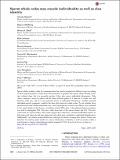Sperm whale codas may encode individuality as well as clan identity
Abstract
Sperm whales produce codas for communication that can be grouped into different types according to their temporal patterns. Codas have led researchers to propose that sperm whales belong to distinct cultural clans, but it is presently unclear if they also convey individual information. Coda clicks comprise a series of pulses and the delay between pulses is a function of organ size, and therefore body size, and so is one potential source of individual information. Another potential individual-specific parameter could be the inter-click intervals within codas. To test whether these parameters provide reliable individual cues, stereo-hydrophone acoustic tags (Dtags) were attached to five sperm whales of the Azores, recording a total of 802 codas. A discriminant function analysis was used to distinguish 288 5 Regular codas from four of the sperm whales and 183 3 Regular codas from two sperm whales. The results suggest that codas have consistent individual features in their inter-click intervals and inter-pulse intervals which may contribute to individual identification. Additionally, two whales produced different coda types in distinct foraging dive phases. Codas may therefore be used by sperm whales to convey information of identity as well as activity within a social group to a larger extent than previously assumed.
Citation
Oliveira , C , Wahlberg , M , Silva , M A , Johnson , M , Antunes , R , Wisniewska , D M , Fais , A , Gonçalves , J & Madsen , P T 2016 , ' Sperm whale codas may encode individuality as well as clan identity ' , Journal of the Acoustical Society of America , vol. 139 , no. 5 , pp. 2860-2869 . https://doi.org/10.1121/1.4949478
Publication
Journal of the Acoustical Society of America
Status
Peer reviewed
ISSN
0001-4966Type
Journal article
Description
The research was funded by the Danish Research Council; the Carlsberg Foundation; Fundação para a Ciência e a Tecnologia (FCT); Fundo Regional da Ciência, Tecnologia (FRCT) through research projects TRACE-PTDC/MAR/74071/2006 and MAPCET-M2.1.2/F/012/2011 [Fundo Europeu de Desenvolvimento Regional, the Competitiveness Factors Operational (COMPETE), Quadro de Referência Estratégico Nacional (QREN) European Social Fund, and Proconvergencia Açores/European Union Program]; Aarhus University; Woods Hole Oceanographic Institution; University of Southern Denmark and University of La Laguna. We acknowledge funds provided by FCT to MARE – Marine and Environmental Sciences Centre (UID/MAR/04292/2013) and Instituto do Mar at University of the Azores and by the FRCT – Government of the Azores pluriannual funding. C.O. was funded by FCT (SFRH/BD/37668/2007). M.A.S. was supported by an FCT postdoctoral grant (SFRH/BPD/29841/2006) and is currently supported by POPH, QREN European Social Fund and the Portuguese Ministry for Science and Education, through an FCT Investigator grant. M.J. is supported by the Marine Alliance for Science and Technology Scotland (MASTS) and a Marie Curie Career Integration Grant. D.M.W. was funded by a Ph.D. stipend from the Oticon Foundation, Denmark.Collections
Items in the St Andrews Research Repository are protected by copyright, with all rights reserved, unless otherwise indicated.

